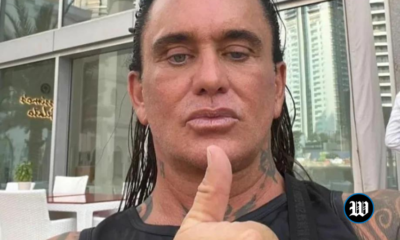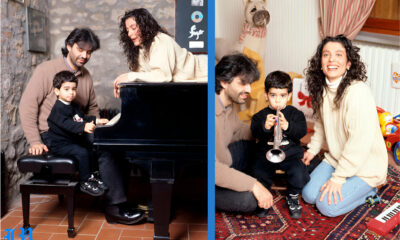Fashion
The World of Dreads Styles, Trends, and Cultural Significance
Published
10 months agoon
By
Bilal
Dreads, also known as dreadlocks, have been a symbol of cultural identity, spirituality, and personal expression for centuries. Whether you’re drawn to the style for its aesthetic appeal or its rich cultural history, dreads offer a unique way to express individuality. In this comprehensive guide, we’ll explore the different styles of dreads, from freeform to high top, delve into popular trends like Jimmy Butler’s dreads, and discuss the differences between dreads and locs.
The Origins and Cultural Significance of Dreads
Dreads have a deep-rooted history that spans various cultures and religions. The style has been worn by people around the world, from the Maasai warriors of East Africa to the Hindu sadhus of India. In many cultures, dreads are more than just a hairstyle; they represent a connection to spirituality, strength, and identity.
The Rastafarian Influence
Perhaps the most well-known association with dreads comes from the Rastafarian movement in Jamaica. For Rastafarians, dreads are a symbol of their religious beliefs and a way to reject the conventions of Western society. The style became widely recognized in the 1970s through the influence of reggae music and icons like Bob Marley, who popularized the look and its cultural significance.
Modern Interpretations
Today, dreads are worn by people of all backgrounds, and the style has evolved into a form of self-expression. From artists and musicians to athletes and influencers, dreads have become a versatile and widely accepted hairstyle that can be adapted to suit various tastes and lifestyles.
Exploring Different Dread Styles
One of the most appealing aspects of dreads is the variety of styles available. Whether you prefer a natural, unstructured look or a more polished appearance, there’s a dread style that can reflect your personality and preferences.
Freeform Dreads
Freeform dreads, also known as organic dreads, are created by allowing the hair to naturally lock on its own without the use of manipulation or products. This style is often chosen by those who want a more natural, carefree look. Freeform dreads can vary greatly in size and shape, depending on the individual’s hair texture and the length of time the dreads are allowed to form.
High Top Dreads
High top dreads are a modern variation of the traditional dread style. This look involves shaving the sides of the head while leaving the dreads on top. High top dreads are popular for their clean, edgy appearance and are often combined with fades or other barbering techniques to create a distinctive look.
Temu Dreads
Temu dreads refer to a style that has gained popularity on social media, particularly on platforms like TikTok. These dreads are often characterized by their unique shapes and sizes, created using various twisting and braiding techniques. Temu dreads have become a trend among younger generations, showcasing the versatility and creativity that dreads can offer.
Jimmy Butler Dreads
NBA star Jimmy Butler has made headlines not just for his skills on the basketball court, but also for his bold choice of dreads. Butler’s dreads have become a topic of discussion, especially during the 2020 NBA bubble, where he debuted a new, more intricate dread style. His dreads are often styled in a way that combines both freeform and maintained techniques, reflecting his dynamic personality.
Dreads vs. Locs: What’s the Difference?
The terms “dreads” and “locs” are often used interchangeably, but they can carry different connotations depending on cultural and personal perspectives.
The Term “Dreads”
The word “dreads” is believed to have originated from the term “dreadlocks,” which some suggest was coined by British colonialists who found the style “dreadful.” However, the term has been reclaimed by many as a symbol of pride and resistance. Today, “dreads” is used more casually and widely to describe the style without negative connotations.
The Term “Locs”
“Locs” is a term preferred by many within the African diaspora, as it removes any negative historical context associated with the word “dreads.” Locs are seen as a cultural and spiritual expression, deeply rooted in African traditions. Many people choose to use “locs” to emphasize the cultural significance and the care involved in maintaining the style.
How to Start and Maintain Dreads
Starting and maintaining dreads requires patience, care, and commitment. Whether you’re opting for freeform dreads or a more structured style, understanding the process and upkeep is essential for achieving healthy, long-lasting dreads.
Starting Your Dreads
The method you choose to start your dreads will depend on your hair type, desired look, and personal preferences. Here are some common methods:
- Twisting: This method involves sectioning the hair and twisting it into individual coils. Over time, these twists will lock and form dreads.
- Braiding: Braids can be left in the hair until they begin to lock naturally. This method is often used for thicker, coarser hair types.
- Backcombing: This technique involves teasing the hair with a comb to create knots, which will eventually lock into dreads.
- Freeforming: As mentioned earlier, this method allows the hair to lock naturally without any manipulation.
Maintenance Tips
Maintaining dreads involves regular care to keep them healthy and looking their best. Here are some tips for maintaining your dreads:
- Washing: Contrary to popular belief, dreads should be washed regularly to remove dirt and buildup. Use a residue-free shampoo to keep your dreads clean without leaving any residue that could cause buildup.
- Retwisting: For those who choose to maintain a more structured look, retwisting is necessary to keep the roots neat. This should be done every few weeks, depending on hair growth.
- Moisturizing: Dreads can become dry, so it’s important to keep them moisturized. Use natural oils like coconut or jojoba oil to nourish your dreads and scalp.
- Protecting: Wear a satin or silk scarf at night to protect your dreads from frizz and breakage while you sleep.
The Cultural and Social Impact of Dreads
Dreads are more than just a hairstyle; they are a cultural symbol with deep social significance. In recent years, the acceptance of dreads in various settings, including the workplace and media, has sparked conversations about cultural appropriation, discrimination, and the importance of cultural identity.
Dreads in the Workplace
While dreads have become more widely accepted, there are still instances of discrimination against individuals with dreads, particularly in professional settings. Some employers have policies that discourage or even prohibit dreads, citing them as “unprofessional.” However, there has been a growing movement advocating for the acceptance of natural hairstyles, including dreads, in all environments.
Cultural Appropriation vs. Appreciation
The popularity of dreads among people outside the African diaspora has led to debates about cultural appropriation. While some argue that wearing dreads without understanding their cultural significance is disrespectful, others believe that the style can be appreciated and worn by anyone. It’s important to approach dreads with respect and awareness of their cultural roots.
Conclusion Embracing the Versatility of Dreads
Dreads are a powerful form of self-expression, rich in cultural history and personal significance. Whether you choose freeform dreads, high top dreads, or any other style, maintaining your dreads with care and respect for their cultural roots is key to enjoying this unique hairstyle. From the influence of figures like Jimmy Butler to the modern trends seen on platforms like TikTok, dreads continue to evolve and inspire. Embrace the journey of wearing dreads, and explore the endless possibilities this timeless style has to offer.

Who Is Lynn Hamilton? Celebrating the Life and Legacy of the American Actress

Who is Mickey Gooch Jr? The Dynamic Journey of a Film Producer and Actor

Who Is Pierre Bouvier? All About the Canadian Singer and Musician Behind Simple Plan

Who Is Pearl Minnie Anderson? Rising Star in Maya Rudolph’s Legacy

Who is Minnie Pearl? The American Comedian Who Brought Country Humor to the Spotlight

Who Is Kavan Smith? The Canadian Actor Known for His Versatile Roles

Who is Olivia Rose Cameron: The Creative Artist & Daughter of Kirk Cameron

Who Is Markella Kavenagh? All About the Australian Actress and Rising Star

Who is Tracey Hinds? Exploring the Life of Macy Gray’s Ex-Husband and Mortgage Broker

Who is Eric Weinberger? A Visionary Television Producer Shaping Sports Media

Who Is Dan Jeannotte? All About the Canadian Actor’s Career and Roles

Who Is Paul Fenech? Inside the World of the Australian Filmmaker and Actor

Who Is Merri Kelly Hannity? All About Sean Hannity’s Daughter

Who Is Diana Espinoza Aguilar? The Story of Rafael Caro Quintero’s Wife

Who is Charlee Fraser? The Rise of the Australian Model and Actress Making Global Waves

Who Is James Lesure? All About the American Film and Television Actor

Who is Eric Weinberger? A Visionary Television Producer Shaping Sports Media

Who Is Toru Ohtani? All About Shohei Ohtani’s Father & Baseball Coach

Who is Torrei Hart? The Multitalented Actress and Comedian Making Waves

Who Is Avantika Vandanapu? Rising American Actress & Singer

Who Is Lynn Hamilton? Celebrating the Life and Legacy of the American Actress

Who is Mickey Gooch Jr? The Dynamic Journey of a Film Producer and Actor

Who Is Pierre Bouvier? All About the Canadian Singer and Musician Behind Simple Plan

Who Is Pearl Minnie Anderson? Rising Star in Maya Rudolph’s Legacy

Who is Minnie Pearl? The American Comedian Who Brought Country Humor to the Spotlight

Who Is Kavan Smith? The Canadian Actor Known for His Versatile Roles

Who is Olivia Rose Cameron: The Creative Artist & Daughter of Kirk Cameron

Who Is Markella Kavenagh? All About the Australian Actress and Rising Star

Who is Tracey Hinds? Exploring the Life of Macy Gray’s Ex-Husband and Mortgage Broker

Who is Eric Weinberger? A Visionary Television Producer Shaping Sports Media
Trending
-

 Celebrity11 months ago
Celebrity11 months agoNecati Arabacı: Net Worth, Biography, and More
-

 Celebrity12 months ago
Celebrity12 months agoDiscovering Lily Phillips: An Insight into Her Life and Career
-

 Celebrity12 months ago
Celebrity12 months agoParker Schnabel’s Girlfriend: A Comprehensive Look at His Relationships Over the Years
-

 Celebrity11 months ago
Celebrity11 months agoEnrica Cenzatti: Life of Andrea Bocelli’s Ex-Wife
